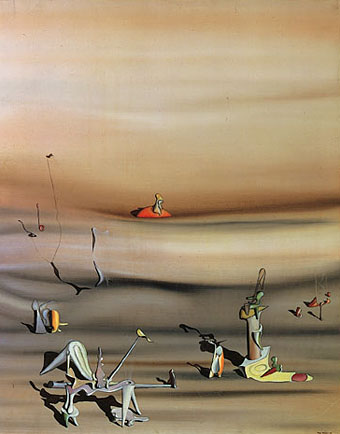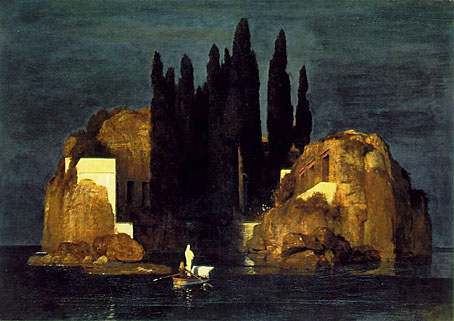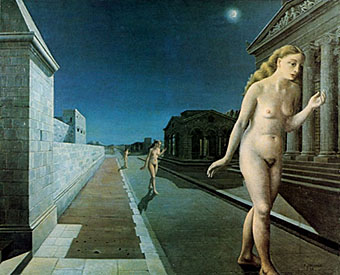
Jours de Lenteur (1937) by Yves Tanguy.
Behind it, the ark of his covenant, stood two photographs in a hinged blackwood frame. On the left was a snapshot of himself at the age of four, sitting on a lawn between his parents before their divorce. On the right, exorcizing this memory, was a faded reproduction of a small painting he had clipped from a magazine, ‘Jours de Lenteur’ by Yves Tanguy. With its smooth, pebble-like objects, drained of all associations, suspended on a washed tidal floor, this painting had helped to free him from the tiresome repetitions of everyday life. The rounded milky forms were isolated on their ocean bed like the houseboat on the exposed bank of the river.
The Drought (1965).
Following my observations yesterday about Ballard’s Surrealist influences, this post seems inevitable. By no means a comprehensive listing, these are merely some of Ballard’s many art references retrieved after a quick browse through the bookshelves earlier. I’d forgotten about the Böcklin reference in The Crystal World. The Surrealist influence in Ballard’s fiction is obvious to even a casual reader, less obvious is the subtle influence of the Surrealist’s precursors, the Symbolists. André Breton frequently enthused over Gustave Moreau‘s airless impasto visions and many of Ballard’s remote femmes fatales owe as much to Moreau’s paintings as they do to Paul Delvaux. The Symbolist connection was finally confirmed for me when RE/Search published their landmark JG Ballard in 1984; there among the list of books on his library shelves was that cult volume of mine, Dreamers of Decadence by Philippe Jullian.
The Robing of the Bride (1940) by Max Ernst.
The ‘Soft’ Death of Marilyn Monroe. Standing in front of him as she dressed, Karen Novotny’s body seemed as smooth and annealed as those frozen planes. Yet a displacement of time would drain away the soft interstices, leaving walls like scraped clinkers. He remembered Ernst’s ‘Robing’: Marilyn’s pitted skin, breasts of carved pumice, volcanic thighs, a face of ash. The widowed bride of Vesuvius.
You: Coma: Marilyn Monroe (1966).

The Isle of the Dead (second version; 1880) by Arnold Böcklin.
In the sudden flares of light over the water, reflected off the sharp points of his cheeks and jaw, a harder profile for a moment showed itself. Conscious of Sanders’s critical eye, Father Balthus added as an afterthought, to reassure the doctor: ‘The light at Port Matarre is always like this, very heavy and penumbral – do you know Böcklin’s painting, “Island of the Dead”, where the cypresses stand guard above a cliff pierced by a hypogeum, while a storm hovers over the sea? It’s in the Kunstmuseum in my native Basel –’
The Crystal World (1966).

The Echo (1943) by Paul Delvaux.
In the students’ gallery hung the fading reproductions of a dozen schools of painting, for the most part images of worlds without meaning. However, grouped together in a small alcove Halliday found the surrealists Delvaux, Chirico and Ernst. These strange landscapes, inspired by dreams that his own could no longer echo, filled Halliday with a profound sense of nostalgia. One above all, Delvaux’s ‘The Echo’, which depicted a naked Junoesque woman walking among immaculate ruins under a midnight sky, reminded him of his own recurrent fantasy. The infinite longing contained in the picture, the synthetic time created by the receding images of the woman, belonged to the landscape of his unseen night.
The Day of Forever (1967).

The Persistence of Memory (1931) by Salvador Dalí.
Franklin opened the centre drawer of his desk and stared at the assemblage laid out like a corpse on its bier of surgical cotton. There was a labelled fragment of lunar rock stolen from the NASA museum in Houston; a photograph taken with a zoom lens of Marion in a hotel bathroom, her white body almost merging into the tiles of the shower stall; a faded reproduction of Dali’s ‘Persistence of Memory’, with its soft watches and expiring embryo; a set of leucotomes whose points were masked by metal peas; and an emergency organ-donor card bequeathing to anyone in need his own brain.
News from the Sun (1982).
• How JG Ballard cast his shadow right across the arts
Previously on { feuilleton }
• Dirty Dalí
• Ballard on Dalí
• Penguin Surrealism
• Taxandria, or Raoul Servais meets Paul Delvaux
• Surrealist women
• Las Pozas and Edward James
• Arnold Böcklin and The Isle of the Dead


Remember also this from The Atrocity Exhibition
The Persistence of Memory. An empty beach with its fused sand. Here clock time is no longer valid. Even the embryo, symbol of secret growth and possibility, is drained and limp. These images are the residues of a remembered moment of time. For Talbot the most disturbing elements are the rectilinear sections of the beach and sea. The displacement of these two images through time, and their marriage with his own continuum, has warped them into the rigid and unyielding structures of his own consciousness. Later, walking along the overpass, he realized that the rectilinear forms of his conscious reality were warped elements from some placid and harmonious future.
Hi James. Yes, The Atrocity Exhibition has painting references throughout, mainly Dalí and Ernst. ‘The Summer Cannibals’ title is derived from Dalí’s Autumn Cannibalism, of course.
Apropos to much of this I’ve been having an interesting time putting some of these into Google’s new ‘Similar Images’ search function. “America’s Ralph Nader of medicine” makes it to the first page of the matches for The Robing of the Bride just by standing around in his garden:
http://preview.tinyurl.com/c6tc2w
I thought the Delvaux above would be a good candidate for similar images, but it doesn’t seem to register any at all.
Fascinating that a couple of Haeckel plates turn up on those Google pages. Would have been more apt for Dalí since he copied one of Haeckel’s organisms in a later painting.
I guess it’s primarily a colour/texture match for the Haeckels. The Pollock showing up is pretty impressive, though perhaps not as impressive as the dog. It could be a great service if they could effectively remove repetitions of the same original source.
The results for Asmodeus suggest that it might not rely entirely on futuristic optical algorithms (though the map of Iran on page 3 is an interesting development).
Cheers for this, John – some great quotes I hadn’t thought about. I almost can’t bear to go back to Ballard right now but I guess it’s kind of inevitable.
The Persistence of Memory is indead disturbing but Salvador Dalí is still one of my favourites.